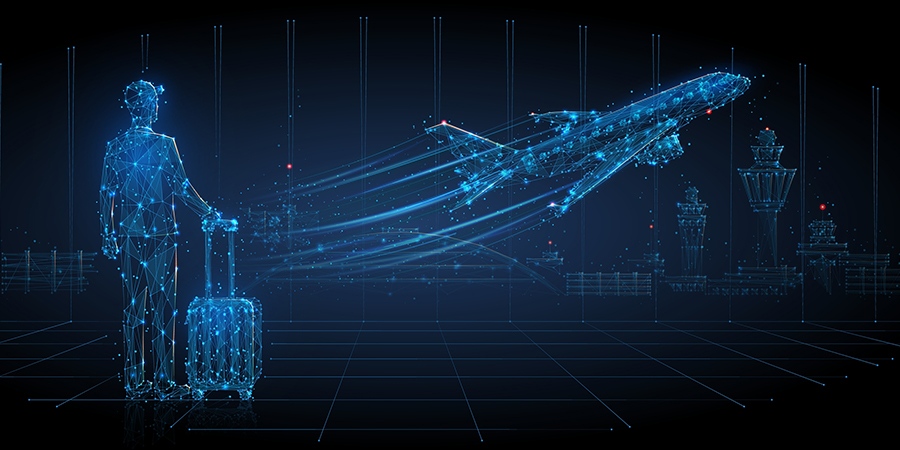Aviation enables both physical as well as informational connections between people and businesses, and its global approach has changed considerably over the years. New technologies and standards are giving rise to connected-anywhere concepts that are enabled by digital ecosystems.
The complexity and interoperability of aviation ecosystems are seen as significant challenges for technology providers, regulators and airlines alike and are driving an accelerated digital transformation.
Now more than ever, air travel is expected to be safe, accessible and convenient. There’s a huge need to adapt rapidly to changing market needs, pushing industry players to be more flexible and agile. As a result, a more connected journey is enhanced digitally through common scenarios such as the booking and managing of flights, creating more efficient ways of navigating airports, tracking luggage and receiving real-time updates of in-transit cargo.
Unsurprisingly, innovation is rapidly changing many industries, and aviation is not exempt. A new era for the aviation industry is ready for takeoff, further bridging the distance between people, services and goods.
While evolving every day, the connectivity brought by 5G through private networks is expected to boom in time. Despite some security concerns raised behind 5G deployment for the aviation sector, the benefits certainly outweigh any possible risks. With proper frequency allocation and suitable preparation for interferences, flights will be undisturbed, with people’s means of communication remaining intact.
What digital connectivity brings
As per Ericsson’s Connected Aviation report, to maximize value from this transformation journey, the sector must align the Aviation 4.0 vision with the use of real-time data from connected devices and the four key pillars for digital transformation: improved productivity, economy progression, enhanced passenger experience and increased safety and security.
More often than not, the connectivity needs of airports and airlines result in private wireless networks – from the passenger terminal and maintenance hangers to hotels and car-rental facilities. This is because cellular engages high-speed, reliable mobile connectivity that enables convergence with existing technologies such as artificial intelligence (AI), edge computing and augmented/virtual reality (AR/VR).
The abovementioned report also estimates that each flight itself needs to offload between 500 GB and 1 TB of data related to sensors, direction and entertainment.
To this end, in Inmarsat’s digital aviation roadmap, within five to ten years, seamless digital communications mobility using heterogeneous and integrated technology environments using LTE, 4G, 5G, satellite and L-band digital aeronautical communication systems (LDACS) will provide greater communications resilience and capacity for both existing and future flight (UAV) systems.
With ultra-reliable and low-latency connectivity, the principle of the “conscious aircraft” can be realized. This includes monitoring the current platform health and then automatically reconfiguring to optimize every aspect of an aircraft’s engineering, connecting all with a human-like nervous system. By using sensing and communication technologies, the increasing awareness that removes risk and unnecessary costs can also avoid problems caused by component degradation, unpredicted technical failures and human error.
Connectivity technologies within the aviation industry, such as 5G, will be at the forefront of growth and represent some of the greatest opportunities for its mid-and-long-term future.
Private 5G networks
5G is proclaimed to be revolutionary in different sectors of society, including aviation. The sky is truly the limit when it comes to 5G’s ability to transform this particular industry. If leveraged properly, 5G deployments will touch every facet of the aviation lifecycle: manufacturing, airport and airline operations, and passenger experience.
The fifth generation of mobile technology is poised to take the industry to new heights in the form of dedicated private networks. Also known as the isolated non-public network as per 3GPP, this built-for-purpose network, in contrast to those open and publicly-available, provides dedicated resources that enable high security and privacy as well as full control over design, timeline and service-level agreements (SLAs).
Ericsson research suggests that the ultra-reliable low-latency communication approach of 5G is most applicable to the digital aviation ecosystem. Wi-Fi and LTE networks are not dependable enough for critical operations, effective fleet management and coordination within an increasing number of connected devices. Private 5G may be the answer.
Through secure and reliable connectivity, airports see performance gains of 20-40% for operations with private 5G networks. This is highly beneficial within the connected architecture in airports and the inflight-connectivity within airlines delivered through its connectivity providers.
To cite an example, 5G can support the automation and smart utilization of airport spaces and provide dedicated coverage and capacity when public networks are congested. Furthermore, by making an easy-to-consumer network in-air similar to enjoying 5G connectivity on the ground, passengers could enjoy and benefit from a 5G-enabled experience via AR/VR capabilities to access 8K or UHD content, or by tapping into faster in-flight entertainment services.
Indeed, private networks pave the way towards a robust and scalable communications infrastructure that integrates data and emerging technologies for a unified experience in which employees, customers and operators are continuously connected.
By delivering high bandwidth, strong capacity and safeguarded private 5G networks, the future connectivity needs and digitalization strategies within the aviation sector can be addressed and actualized.
Flying into digital
Airports and airlines should look for partners with the ability to meet the needs of passengers both today and in the future. This requires a network provider with the commitment and ability to invest in realizing the potential of this vast connectivity opportunity.
Key players present in the 5G market within the aviation industry include Ericsson, Nokia and Huawei, with PCCW Global and Intelsat also making significant contributions to aviation-specific solutions.
Airbus is working with Ericsson to provide a secure connectivity solution that supports aeronautical engineering and final assembly line production by providing secure onsite data transfer between engineering teams and device connection on-site via narrowband IoT (NB-IoT). This features a 4G private network that is 5G-ready and includes a robust and redundant core network connected to radio solutions running on mid-band 700 MHz and 2600MHz TDD.
Huawei’s smart airport solution propels airport digital transformation by improving passenger satisfaction and airport operational efficiency. Utilizing the Horizon Digital Platform to integrate multiple new technologies – including AI, IoT, video cloud and big data – this solution focuses on three airport business domains: operations control, security and services. One ID for Airport Travel and One Map for Airport Operations are two tailor-made solutions that streamline passenger and flight flows. On the airline side, Emirates has boosted its partnership with Huawei to elevate its digital customer experience, expanding the Emirates app availability in the AppGallery.
For Nokia, deploying an industrial-grade private wireless solution with its Digital Automation Cloud (DAC) provides easy-to-deploy, pervasive connectivity that can help airports ensure safe, on-time and fully connected journeys. It provides a dedicated, 5G-ready operational network that delivers the reliability, predictability and low latency needed for critical operational services and applications. Ukkoverkot, a Finnish private network operator, has signed local airport operator Finavia as their first micro-operator customer, building a private LTE network for Helsinki airport with Nokia technology.
PCCW Global and Frequentis have collaborated to deliver aviation-specific software-as-a-service (SaaS) technologies over the newly-commissioned Common Aeronautical Virtual Private Network (CRV) that serves International Civil Aviation Organization (ICAO)’s Asia Pacific and the Middle East (APAC and MID) regions. Offering value-added services on top of the advanced aeronautical network, it provides critical information through the globally interoperable system-wide information management (SWIM) infrastructure, interfaces and exchange models.
Intelsat has also launched a new inflight connectivity (IFC) solution powered by electronically-steered antenna (ESA) technology. Lighter, and more versatile than previous options, the new ESA-based solution is the first in a new line of ground-breaking multi-orbit terminals developed by the satellite operator, with the capability to interoperate with GEO, LEO and MEO satellites.











